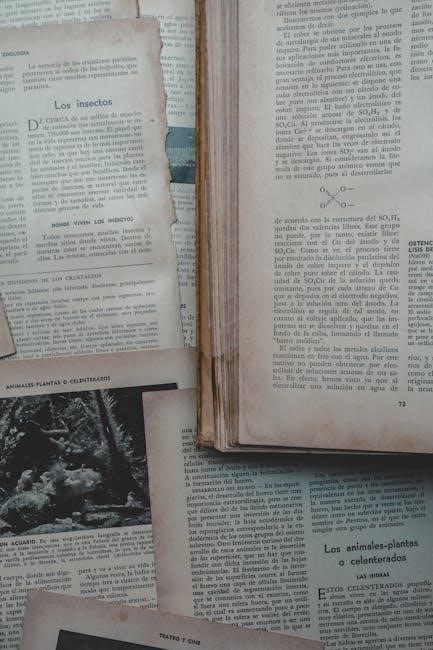Spanish Cheat Sheet PDF: An Overview
A Spanish cheat sheet PDF offers a concise summary of essential grammar rules and vocabulary. It’s a valuable tool for learners of all levels, providing quick access to key concepts like verb conjugations and sentence structure, aiding in efficient learning and review.
What is a Spanish Grammar Cheat Sheet?
A Spanish grammar cheat sheet is a condensed resource designed to aid learners in understanding and applying the fundamental rules of the Spanish language. It serves as a quick reference guide, summarizing key grammatical concepts in an easily accessible format. Typically, it includes essential elements such as verb conjugations, noun-adjective agreement, pronoun usage, and common sentence structures. The goal is to provide a readily available tool that helps students recall and apply grammatical rules correctly when speaking or writing in Spanish.
These cheat sheets are particularly helpful for students who are new to the language or those who need a refresher on specific grammar points. They eliminate the need to sift through extensive textbooks, offering a streamlined overview of the most important rules. By using a cheat sheet, learners can quickly check their understanding, reinforce their knowledge, and improve their accuracy in Spanish communication. Furthermore, they promote independent learning and self-correction, empowering students to take control of their language acquisition journey.

Key Components of a Spanish Grammar Cheat Sheet
A comprehensive Spanish grammar cheat sheet typically includes verb conjugations across various tenses, noun and adjective agreement based on gender and number, pronoun usage, essential prepositions, and common sentence structures for effective communication.
Verb Conjugations
Verb conjugations are a cornerstone of Spanish grammar, dictating how verbs change based on tense, mood, and person. A cheat sheet provides a quick reference for these conjugations, focusing on regular verbs like “-ar,” “-er,” and “-ir” verbs in present, past (preterite and imperfect), and future tenses.
Irregular verbs, which deviate from standard conjugation patterns, are also highlighted. Common irregular verbs such as “ser,” “estar,” “tener,” and “ir” are crucial to master. The cheat sheet should showcase their unique forms across various tenses.
Furthermore, reflexive verbs and their conjugation nuances should be included. Understanding how reflexive pronouns affect verb forms is essential for constructing grammatically correct sentences.
The subjunctive mood, used to express doubts, desires, and possibilities, warrants special attention. Cheat sheets often present the most common subjunctive conjugations, particularly in present and imperfect subjunctive tenses. Mastering verb conjugations is essential for fluency.
Articles and Nouns (Gender and Number)
In Spanish, every noun has a gender, either masculine or feminine, which affects the articles and adjectives used with it. “El” and “la” are the definite articles, meaning “the,” used before masculine and feminine nouns, respectively. “Un” and “una” are the indefinite articles, meaning “a” or “an,” also corresponding to gender.
Nouns ending in “-o” are typically masculine, while those ending in “-a” are usually feminine, though there are exceptions. For example, “la mano” (the hand) is feminine despite ending in “-o.” Adjectives must agree in gender and number with the nouns they modify. If a noun is feminine, the adjective must also be feminine.
To make nouns plural, generally add “-s” to nouns ending in a vowel and “-es” to nouns ending in a consonant. Articles also change to “los” and “las” for plural definite articles, and “unos” and “unas” for plural indefinite articles. Understanding these rules is fundamental to correct Spanish grammar.
Pronouns
Pronouns in Spanish are essential for avoiding repetition and clarifying who or what is being discussed. Subject pronouns include “yo” (I), “tú” (you, informal), “él” (he), “ella” (she), “usted” (you, formal), “nosotros/nosotras” (we), “vosotros/vosotras” (you, plural, informal, mainly used in Spain), and “ellos/ellas/ustedes” (they/you, plural, formal).
Object pronouns replace nouns that receive the action of a verb. Direct object pronouns (me, te, lo/la, nos, os, los/las) receive the verb’s action directly, while indirect object pronouns (me, te, le, nos, os, les) indicate to whom or for whom the action is done. Reflexive pronouns (me, te, se, nos, os, se) are used when the subject and object are the same.
Possessive pronouns (mío, tuyo, suyo, nuestro, vuestro, suyo) indicate ownership, and demonstrative pronouns (este, ese, aquel) point out specific nouns. Mastering these pronouns is crucial for constructing clear and grammatically correct Spanish sentences.
Common Tenses (Present, Past, Future)
Understanding common tenses is fundamental to Spanish grammar. The present tense (presente) describes actions happening now or habitual actions. Regular verbs follow predictable conjugation patterns, while irregular verbs require memorization.
The past tense encompasses several forms. The preterite (pretérito) expresses completed actions in the past. The imperfect (imperfecto) describes ongoing or habitual actions in the past, as well as states of being. The future tense (futuro) indicates actions that will occur in the future. The near future (ir + a + infinitive) is also frequently used to express future plans.
Mastering these tenses enables effective communication in Spanish, allowing you to discuss events happening now, recount past experiences, and express future intentions. Cheat sheets often provide conjugation tables and examples for regular and common irregular verbs in these tenses, facilitating quick reference and accurate usage. Recognizing the nuances between these tenses is key to fluency.
Essential Prepositions
Prepositions are vital for constructing meaningful sentences in Spanish, indicating relationships between words. Key prepositions include “a” (to, at), “de” (of, from), “en” (in, on, at), “por” (for, by, through), and “para” (for, to, in order to). Understanding their various uses is crucial.
“A” often indicates direction or purpose, while “de” denotes possession or origin. “En” specifies location or time. “Por” expresses reason, motive, or exchange, and “para” indicates destination, purpose, or recipient;
Mastering these prepositions enhances comprehension and fluency. Spanish cheat sheets often provide lists of common prepositions and examples of their usage in different contexts. Prepositional phrases add detail and precision to your Spanish, enabling you to express complex ideas and relationships. Correct preposition usage is essential for clear and accurate communication, as incorrect prepositions can alter the meaning of a sentence. Recognizing the subtle differences between similar prepositions is key.

Benefits of Using a Spanish Cheat Sheet
Using a Spanish cheat sheet offers numerous benefits for language learners. Firstly, it provides a quick reference guide, saving time and effort when studying or practicing Spanish. By consolidating key grammar rules, verb conjugations, and vocabulary, it eliminates the need to constantly flip through textbooks or search online.
Cheat sheets boost confidence by providing readily accessible information, reducing anxiety during conversations or exams. They serve as excellent study aids, reinforcing learning and improving retention. With a cheat sheet, learners can quickly review essential concepts before engaging in real-world scenarios, such as ordering food or asking for directions.
Spanish cheat sheets also foster independent learning by enabling learners to self-correct and identify areas needing improvement. They are particularly useful for visual learners who benefit from concise and organized information. Ultimately, using a Spanish cheat sheet accelerates progress and enhances the overall learning experience, making it a valuable tool for mastering the language.
Where to Find Spanish Cheat Sheets in PDF Format
Spanish cheat sheets in PDF format are readily available online. Look for them on language learning websites, educational resource sites, and even through simple Google searches. Many are offered for free or at a low cost.
Online Resources
The internet is a treasure trove when searching for Spanish cheat sheets in PDF format. Numerous websites offer downloadable resources to aid in your language learning journey. Many educational websites and language learning platforms provide free or premium cheat sheets covering various aspects of Spanish grammar and vocabulary.
Start by searching on Google or other search engines using keywords like “Spanish grammar cheat sheet PDF” or “free Spanish verb conjugation chart.” You’ll likely find a wealth of options from different sources. Be sure to evaluate the credibility of the source before downloading any materials.
Some websites may require you to sign up for a free account to access their resources, while others may offer them directly for download. Look for cheat sheets that align with your specific learning needs, whether you’re focusing on verb tenses, sentence structure, or common phrases. Remember to always scan downloaded files for viruses before opening them.
Language Learning Websites
Dedicated language learning websites are a prime location to discover valuable Spanish cheat sheets in PDF format. Platforms like Duolingo, Memrise, and Babbel often provide supplementary resources to complement their courses, including downloadable cheat sheets covering essential grammar and vocabulary.
These websites frequently curate their content to align with specific learning levels, ensuring that you find cheat sheets suitable for your current proficiency. Many offer comprehensive guides that cover a wide range of topics, from basic greetings and introductions to more advanced grammar concepts like subjunctive mood and conditional sentences.
Furthermore, language learning websites often feature interactive exercises and quizzes to reinforce your understanding of the material presented in the cheat sheets. This integrated approach can significantly enhance your learning experience and help you master the Spanish language more effectively. Explore the resources sections of these websites to discover a wealth of helpful PDFs.

Mastering Spanish Verb Tenses Cheat Sheet PDF
A dedicated “Mastering Spanish Verb Tenses Cheat Sheet PDF” is an indispensable resource for Spanish language learners aiming to conquer the complexities of verb conjugation. Spanish verbs change significantly depending on the tense, making it crucial to have a quick reference guide.
This type of cheat sheet typically includes detailed tables outlining the conjugations for regular and irregular verbs across various tenses, such as present, past (preterite and imperfect), future, conditional, and subjunctive. It may also provide examples of how to use each tense in context, clarifying their specific meanings and applications.
Furthermore, an effective verb tense cheat sheet often incorporates memory aids and mnemonics to help learners recall the different forms and patterns. By having this resource readily available, students can quickly look up the correct conjugation, improving their fluency and accuracy in both written and spoken Spanish. It’s a cornerstone for confident communication.
Spanish Grammar Basics Cheat Sheet PDF
A “Spanish Grammar Basics Cheat Sheet PDF” is a fundamental tool for anyone embarking on the journey of learning the Spanish language. It serves as a concise and easily accessible reference for the core grammatical concepts that form the foundation of Spanish communication.
Typically, this type of cheat sheet includes essential elements such as noun genders (masculine and feminine), articles (definite and indefinite), basic verb conjugations in the present tense for regular verbs, and common pronouns. It also often covers fundamental sentence structure, question formation, and essential prepositions.
Furthermore, a well-designed basics cheat sheet provides examples of how these grammatical elements are used in simple sentences, allowing learners to quickly grasp the practical application of the rules. By focusing on the most crucial concepts, it empowers beginners to start constructing grammatically correct sentences and building a solid foundation for further language acquisition. It is an invaluable resource for early success.

Free Spanish Grammar Courses PDFs
Accessing free Spanish grammar courses in PDF format presents a fantastic opportunity for self-directed language learning. These resources often provide comprehensive lessons, exercises, and explanations covering various aspects of Spanish grammar, from beginner to advanced levels.
These PDFs typically include detailed explanations of verb conjugations, noun-adjective agreement, pronoun usage, and sentence structure. They also often feature exercises to reinforce learning and test comprehension. Many free courses are structured to progressively build your understanding, starting with the basics and gradually introducing more complex concepts.
Finding quality free Spanish grammar courses in PDF format can significantly supplement your learning, whether you’re a complete beginner or looking to refine your existing skills. They offer a convenient and accessible way to study at your own pace, without the need for expensive textbooks or formal classes, making language learning affordable and attainable for everyone. Look for reputable sources;


